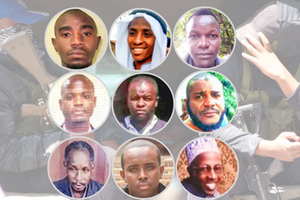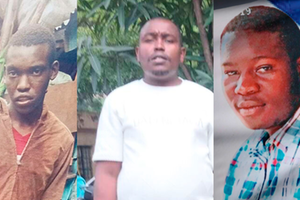
Demonstrators carry the body of a protester who was shot dead at Parliament Buildings during anti-government protests in Nairobi on June 25, 2024.
Kenyan authorities put pressure on BBC to halt the screening of a report showing police officers who shot dead anti-tax protestors at Parliament during demonstrations in June last year.
The private screening was to be held at a cinema within a restaurant in Nairobi.
This emerged as pressure mounted on the government to take action on rogue security officers who unlawfully killed and maimed scores of unarmed protestors.
“A screening of BBC Africa Eye’s 'Blood Parliament in Kenya' was cancelled due to pressure from the authorities. We are very disappointed not to have been able to share the documentary and panel discussion as planned. In the meantime, audiences can watch the film on BBC Africa’s YouTube channel," a BBC spokesperson said.
A major case of focus in the expose is the shooting dead of Eric Shieni who was a Finance student at the University of Nairobi.
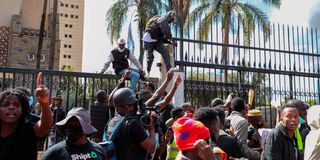
Members of the public protest outside Parliament Buildings in Nairobi on June 25, 2024.
He was shot dead from behind as he left the parliament grounds. BBC in its expose said that he was unarmed.
The media house analysed more than 150 images that were taken after and before Shieni was shot and they were able to identify the soldier who fired at the back of his head.
The identity of the officer is yet to be made public but his images have been widely circulated on various social media platforms.
According to the BBC expose the shooter was a member of Kenya's armed forces.
However, the Kenya Defence Force (KDF) has dismissed the expose by BBC which linked its officer to the death of one of the protesters in Parliament during the June 25, 2024 protests against a controversial finance bill.
In a communication to the Nation, KDF Spokesperson Paul Njuguna said that the Independent Policing Oversight Authority (IPOA) at the time said that they had kicked off investigations on what took place during the nationwide protests.
He said that so far they had not been contacted by IPOA in relation to the alleged case involving an officer of KDF, which was deployed to assist the National Police Service restore order.
“IPOA has so far not forwarded any enquiries, information or request to investigate any KDF personnel that were involved in the operations in support of NPS during the period, nor have they published the report,” Mr Njuguna said.
According to him, KDF remains fully committed to upholding the rule of law and continues to operate strictly within the mandate granted by the Constitution and applicable authorisations.
Law Society of Kenya (LSK) member Mr Hosea Manwa told the Nation that it is time details of the expose are investigated.
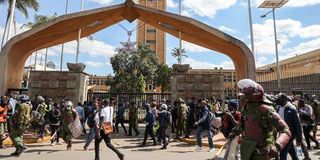
Security officers try to restrain protesters from accessing Parliament buildings on June 25.
Mr Manwa who was amongst a number of lawyers who closely followed the cases of disappearance linked to the protests said that it was disheartening that even soldiers had been implicated in this.
“It is time the details in the expose are investigated, in addition if at all anyone is found guilty then action should be taken against them,” he said.
According to the Kenyan government, 42 people died, 132 went missing and 1,208 were arrested during the protests.
These figures were issued by Prof Kithure Kindiki who is currently the Deputy President at a time when he was serving as the Interior CS.
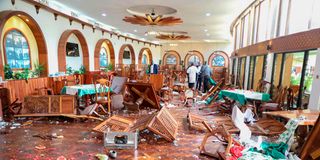
Broken furniture inside the dinning hall at Parliament Buildings after protesters stormed and vandalized Parliament on June 25, 2024.
It is not a norm for the KDF to be involved in such operations but the then Defence Minister Aden Duale issued an order that they support officers attached to the National Police Service (NPS) in response to the security emergency caused by the violent protests.
The deployment was gazetted vide notice 7868 of 2024.
KDF officers are purely tasked with securing the Kenyan borders and they were deployed pursuant to Article 241 (3) (b) of the Kenyan Constitution.
Details of the expose were retrieved after an analysis of more than 5,000 images which also revealed that those killed were not armed and did not pose any threat.

